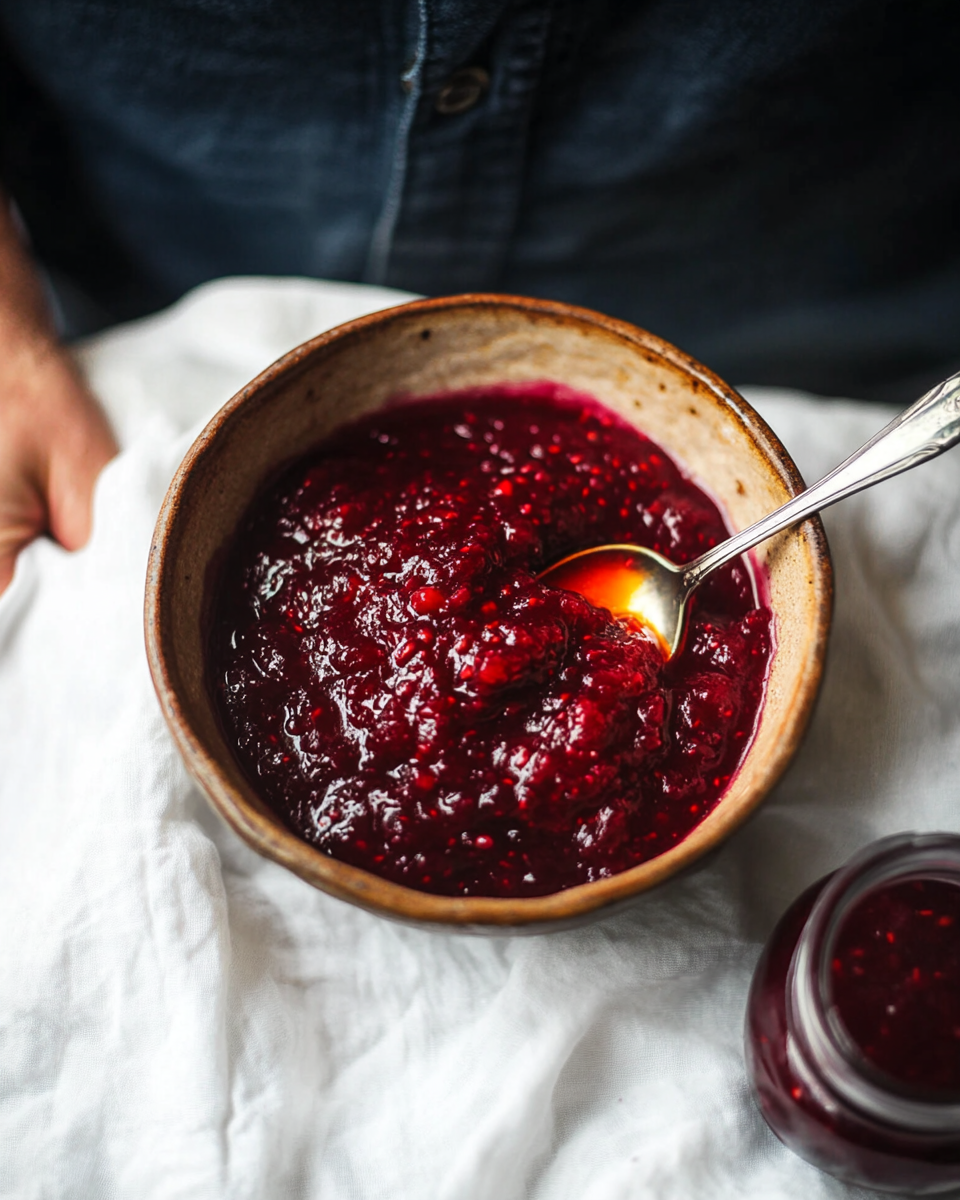This Rhubarb Raspberry Compote is a delightful blend of tart rhubarb and sweet raspberries, cooked down into a thick, luscious sauce. Perfect as a topping for yogurt, pancakes, or desserts, this traditional recipe brings a fresh burst of flavor to any dish.
FULL RECIPE
Ingredients
- 3 cups rhubarb, chopped
- 2 cups fresh or frozen raspberries
- 3/4 cup granulated sugar
- 1 tablespoon lemon juice
- 1 teaspoon vanilla extract (optional)
- 1/4 cup water
Directions
- Combine rhubarb, raspberries, sugar, lemon juice, and water in a medium saucepan.
- Cook over medium heat, stirring occasionally until the fruit breaks down and the mixture thickens, about 15-20 minutes.
- Remove from heat and stir in vanilla extract if using.
- Let cool slightly before serving or storing. Refrigerate in an airtight container for up to one week.
Nutritional Information
- Calories: 70
- Carbohydrates: 18g
- Sugars: 15g
- Fiber: 2g
- Protein: 0.5g
- Fat: 0g
The History of Rhubarb Raspberry Compote
Rhubarb and raspberry have been paired in traditional recipes for centuries, dating back to early European kitchens where rhubarb was prized for its tartness. The compote, a classic French preparation, evolved as a simple way to preserve and enjoy seasonal fruits throughout the year. This dish has remained popular because of its balance of sweet and tangy flavors, making it a versatile accompaniment for many desserts.
The Role of Rhubarb in the Compote
Rhubarb provides the signature tartness in this compote. Its fibrous stalks soften when cooked, releasing natural pectin that helps thicken the sauce without needing additional thickeners. The bright pink or red color of rhubarb also adds visual appeal, making the compote not only delicious but attractive on the plate.
Why Raspberries Complement Rhubarb
Raspberries bring a natural sweetness and vibrant color that complement the sharpness of rhubarb. Their juicy texture adds a luscious element to the compote, balancing acidity with gentle fruity notes. The combination creates a complex flavor profile that excites the palate.
Seasonality and Freshness
The best rhubarb and raspberries are fresh and in season, usually spring to early summer. Using fresh produce ensures the compote has bright, intense flavors and optimal texture. However, frozen raspberries can also be used effectively, making the recipe accessible year-round.
Nutritional Benefits
This compote is low in calories and fat while being a good source of dietary fiber and vitamins, especially vitamin C and antioxidants from the berries. It’s a wholesome alternative to sugary sauces and syrups, offering health benefits alongside delicious flavor.
Natural Sweeteners vs. Refined Sugar
While this recipe uses granulated sugar for sweetness, alternatives like honey, maple syrup, or agave nectar can be used to add complexity and reduce refined sugar content. Adjusting sweetness also allows tailoring to personal dietary preferences or health goals.
The Importance of Lemon Juice
Lemon juice brightens the compote and balances the sweetness with a touch of acidity. It also helps preserve the vibrant color of the fruit and adds a fresh citrus note that enhances the overall flavor.
Variations on the Classic Recipe
Many variations exist, such as adding spices like cinnamon or ginger for warmth, or including other fruits like strawberries or blueberries for different flavor combinations. These variations make the compote adaptable to different tastes and occasions.
Uses Beyond Dessert
While commonly served over desserts, rhubarb raspberry compote can also be used as a topping for breakfast items like pancakes, waffles, and oatmeal, or as a condiment alongside savory dishes such as roasted meats or cheese platters, showcasing its versatility.
Storing and Preserving the Compote
Proper storage extends the life of the compote. It should be kept refrigerated in an airtight container and consumed within a week for the best taste and safety. The compote can also be frozen for longer storage, maintaining flavor and texture when thawed.
How to Incorporate Compote into Baking
This compote can be swirled into yogurt, cakes, or muffins before baking for added moisture and flavor. It works as a filling for pastries, tarts, or layered desserts, bringing brightness and a fruity punch to baked goods.
The Texture and Consistency
Achieving the right thickness is key to a good compote. The natural pectin in rhubarb helps, but cooking time and water content affect the final consistency. A well-made compote is thick enough to coat a spoon but still pourable.
The Science of Cooking Rhubarb and Raspberries
Cooking breaks down the cell walls of the fruit, releasing natural pectin which thickens the sauce. The heat also intensifies flavors while softening texture. Gentle simmering preserves delicate raspberry flavors without turning them to mush.
Cultural Significance
Rhubarb compote is a staple in many cultures, especially in European cuisine. It reflects seasonal cooking traditions and the ingenuity of preserving fresh fruit flavors simply and deliciously.
Pairing the Compote with Other Foods
This compote pairs beautifully with creamy textures such as ice cream, custards, or soft cheeses. Its tartness cuts through rich flavors, creating a harmonious balance in the dish.
Health Considerations
Being low-fat and rich in antioxidants, this compote fits well in balanced diets. However, people with kidney issues should consume rhubarb in moderation due to its oxalate content.
Making Compote for Special Diets
This recipe can easily be adapted for vegan, gluten-free, or low-sugar diets by selecting suitable sweeteners and avoiding additives. Its simplicity makes it a friendly option for various dietary needs.
Enhancing Flavor with Spices and Herbs
Adding fresh herbs like mint or basil, or warming spices such as cloves or star anise, can elevate the compote’s flavor. These additions provide a gourmet touch and freshness.
Presentation Ideas
Serving the compote in small glass jars, alongside fresh fruit or dollops of cream, can make an appealing presentation. Garnishing with mint leaves or citrus zest adds a pop of color and aroma.
Conclusion
Rhubarb raspberry compote is a timeless, versatile preparation that brings together the best qualities of tart and sweet fruits. Its natural nutrition, ease of preparation, and adaptability make it a valuable recipe to have in any kitchen. Whether used as a topping, a baking ingredient, or enjoyed on its own, this compote celebrates the beauty of seasonal fruit in a delicious, healthy way. Its rich history and simple elegance continue to inspire cooks around the world, proving that traditional recipes can remain relevant and beloved across generations.






